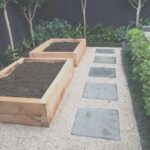Is concrete bad for vegetable gardens? Choosing the right materials for your vegetable garden is crucial for its success. In this article, we will explore the pros and cons of using concrete in vegetable gardens, as well as its impact on soil quality and potential leaching of chemicals. We will also discuss alternative materials for vegetable garden construction and provide tips for using concrete effectively.
When it comes to building a thriving vegetable garden, the materials you choose can make all the difference. Many gardeners wonder about the suitability of using concrete in their gardens, and it’s important to weigh the advantages and disadvantages before making a decision.
Concrete offers durability and stability, making it a popular choice for raised beds and pathways in vegetable gardens. However, there are concerns about how concrete can affect soil quality, potentially altering pH levels and drainage. Additionally, there is the risk of harmful chemicals leaching from the concrete into the soil, which could impact the health of your vegetables.
In this article, we will delve into these considerations and explore alternative materials that can be used for building raised beds and pathways in vegetable gardens. Additionally, we will share case studies of successful vegetable gardens that have thrived despite using concrete as a building material.
If you’re considering using concrete in your vegetable garden or are simply curious about its implications, read on to discover best practices and tips for an effective use of concrete in your garden design.
Pros and Cons of Using Concrete in Vegetable Gardens
When it comes to constructing vegetable gardens, the choice of materials plays a significant role in determining the success of the garden. Concrete is a popular material used for building raised beds, pathways, and retaining walls in vegetable gardens. However, like any other material, concrete has its own set of pros and cons that should be carefully considered before use.
Benefits of Using Concrete
Concrete offers several benefits when used in vegetable gardens. One of the main advantages is its durability and longevity. Unlike wood or other materials that may rot or deteriorate over time, concrete structures can last for many years with minimal maintenance. In addition, concrete provides excellent support for raised beds and can help prevent soil erosion in sloped areas. It also presents a clean and organized look to the garden.
Drawbacks of Using Concrete
Despite its benefits, there are some drawbacks to using concrete in vegetable gardens. One major concern is the potential impact on soil quality. The high pH levels of concrete can affect the natural pH balance of the soil over time, making it less ideal for certain vegetables that thrive in more acidic conditions. Furthermore, poor drainage can occur with excessive use of concrete, resulting in waterlogged soil which can be detrimental to plant growth.
In summary, while concrete offers durability and stability for vegetable gardens, its negative effects on soil quality must be taken into consideration before use. Gardeners must weigh these pros and cons carefully when deciding whether to incorporate concrete into their garden construction projects. Understanding these factors will help make an informed decision on whether or not concrete is suitable for their specific gardening needs.
Impact of Concrete on Soil Quality
Concrete is a popular material for building raised beds and pathways in vegetable gardens due to its durability and low maintenance. However, it’s important to consider how concrete can impact the quality of the soil in these gardens. The pH levels and drainage of the soil are crucial factors that can be affected by the use of concrete.
Pros and cons of using concrete in vegetable gardens:
- Pros: Long-lasting, low maintenance, helps retain moisture in the soil
- Cons: Can affect soil pH, restrict root growth, can leach harmful chemicals
Impact on Soil Quality:
One of the main concerns with using concrete in vegetable gardens is its potential to alter the pH levels and drainage of the soil. Concrete is alkaline in nature and can increase the pH levels of the surrounding soil over time. This can lead to imbalances that may hinder plant growth and nutrient absorption. Additionally, concrete can also restrict proper drainage in the soil, leading to waterlogging and affecting root development.
Potential solutions:
To mitigate these negative impacts on soil quality, there are several precautions that gardeners can take when using concrete in their vegetable gardens. Adding organic matter such as compost or peat moss to the soil can help counteract the alkalinity caused by concrete. In addition, ensuring proper irrigation and good drainage through raised beds or channels is crucial for maintaining healthy soil conditions despite using concrete structures within the garden.
Potential Leaching of Chemicals From Concrete Into the Soil
Concrete is a popular material for building raised beds and pathways in vegetable gardens due to its durability and ease of maintenance. However, there is a concern about the potential leaching of chemicals from concrete into the soil, which can have an impact on the vegetables grown in the garden. It is important to carefully consider this risk when deciding whether to use concrete in a vegetable garden.
One potential issue with using concrete in vegetable gardens is the leaching of lime, which can increase the pH levels of the soil. This can be detrimental to certain types of vegetables that thrive in more acidic soil. Additionally, some studies have found that heavy metals such as lead and cadmium can leach from concrete into the soil, posing a risk to both the plants and those consuming them.
To mitigate these risks, it is important to take measures to prevent or minimize the leaching of chemicals from concrete into the soil. One way to do this is by using a sealant on the surface of the concrete to create a barrier between it and the soil. Additionally, lining the inside of concrete raised beds with a safe material such as plastic or untreated wood can help prevent direct contact between the concrete and the soil.
Alternatives to Concrete for Vegetable Garden Construction
When it comes to constructing raised beds and pathways in vegetable gardens, there are several alternatives to using concrete that can have less impact on soil quality and the environment. One popular option is using natural wood, such as cedar or redwood, which is not only aesthetically pleasing but also safe for growing vegetables. These types of wood are resistant to decay and can last for many years, making them a sustainable choice for garden construction.
Another alternative to concrete is using composite lumber made from recycled materials. This type of material is highly durable and low maintenance, making it a long-lasting choice for building raised beds and pathways in vegetable gardens. Additionally, composite lumber is resistant to rotting, warping, and insect damage, ensuring that it will maintain its structural integrity over time.
For those looking for a more budget-friendly alternative to concrete, using untreated natural stone can be a great option. Stone can add a rustic charm to vegetable gardens while providing good drainage and preventing soil compaction. However, it’s important to note that certain types of stone may affect the pH levels of the soil, so it’s essential to consult with a gardening expert before choosing this option.
| Alternative Material | Benefits |
|---|---|
| Natural Wood (cedar or redwood) | Resistant to decay, aesthetically pleasing |
| Composite Lumber | Made from recycled materials, highly durable |
| Untreated Natural Stone | Rustic charm, good drainage |
Case Studies of Successful Vegetable Gardens Using Concrete
Incorporating concrete into vegetable garden construction has long been a topic of debate among gardeners. Some argue that the use of concrete can have negative effects on soil quality and potentially harm the vegetables grown in the garden.
However, there are also successful cases of vegetable gardens thriving with the use of concrete as a building material. In this section, we will delve into some real-life examples of vegetable gardens that have defied the skepticism and have shown resilience and prosperity despite utilizing concrete.
Community Garden in Urban Setting
One notable case study is a community garden located in an urban setting where space is limited. Due to space constraints, the gardeners opted to build raised beds using concrete as it provided a durable and long-lasting solution. Despite initial concerns about the impact on soil quality, the garden has flourished over the years. The use of raised beds made from concrete provided stability and protection for the vegetables, allowing them to thrive even in an urban environment.
Residential Vegetable Garden
Another compelling example is a residential vegetable garden that incorporated concrete pathways for easy access and maintenance. The use of concrete allowed for efficient management of the garden by providing clear walkways and minimizing weed growth between planting beds. Despite initial concerns about potential leaching of chemicals from the concrete, careful selection of materials and proper sealing techniques have prevented any adverse effects on soil and plant health.
Commercial Farm Utilizing Concrete Structures
In addition to individual gardens, there are also successful commercial farms that have utilized concrete structures for various purposes such as retaining walls, irrigation channels, and storage areas. Despite initial reservations about the potential drawbacks of using concrete in agricultural settings, these farms have demonstrated how strategic use of concrete can contribute to efficiency and productivity without compromising soil quality or plant health.
These case studies serve as compelling evidence that when used thoughtfully and strategically, concrete can be successfully incorporated into vegetable gardens without detrimental effects on plant growth or soil quality. By following best practices and implementing proper construction techniques, it is possible to harness the benefits of using concrete while mitigating any potential drawbacks.
Tips for Using Concrete in Vegetable Gardens
When choosing to use concrete in vegetable gardens, there are several best practices and tips to keep in mind in order to minimize any potential negative impacts on the plants and the soil. One important tip is to line the inside of the concrete bed with a protective barrier such as heavy-duty plastic or landscape fabric. This can help prevent direct contact between the concrete and the soil, reducing the risk of chemicals leaching into the earth.
Additionally, it’s crucial to choose a high-quality, food-safe concrete mix that does not contain harmful additives or chemicals that could potentially seep into the soil. It’s also recommended to cure the concrete properly before planting any vegetables in order to allow any remaining chemical residues from the manufacturing process to dissipate.
In terms of maintenance, regularly inspecting concrete structures for cracks or damage can also help prevent any leaching of chemicals into the soil. Repairing any issues promptly can ensure that the integrity of the concrete is maintained and that it remains a safe material for vegetable gardening. By following these tips and best practices, it is possible to use concrete in vegetable gardens without significantly impacting plant health or soil quality.
Conclusion
In conclusion, when it comes to the question of whether concrete is bad for vegetable gardens, the answer is not a simple yes or no. As discussed in this article, there are pros and cons to using concrete in vegetable garden construction. On one hand, concrete can provide long-lasting and durable infrastructure for raised beds and pathways. On the other hand, it can also affect soil quality and pose potential risks of chemical leaching.
It is important for gardeners to carefully weigh these factors when deciding whether to use concrete in their vegetable gardens. If they do choose to use concrete, there are best practices that can be followed to minimize its negative impact on soil quality and plant health. Additionally, exploring alternative materials such as untreated wood or natural stone can provide viable options for building vegetable garden structures without the potential drawbacks of using concrete.
Ultimately, the decision of whether concrete is bad for vegetable gardens depends on various factors such as local climate, soil composition, and maintenance practices. By considering these factors and being mindful of the potential implications of using concrete, gardeners can make informed decisions that will contribute to the overall success and sustainability of their vegetable gardens.
Frequently Asked Questions
Is Concrete Safe for Vegetable Gardens?
Concrete can be safe for vegetable gardens if certain precautions are taken. It is important to ensure that the concrete used does not leach any harmful chemicals into the soil. Additionally, raised beds or containers can be used to create a barrier between the concrete and the garden soil, reducing the potential for contamination.
Can I Put a Raised Bed on Concrete?
Yes, you can put a raised bed on concrete. In fact, using raised beds on concrete can be beneficial as it provides a stable and level surface for gardening. By using a raised bed, you can control the quality of the soil and improve drainage, which is essential for successful vegetable gardening.
Can You Grow Plants Over Concrete?
It is possible to grow plants over concrete by utilizing raised beds, containers, or vertical gardening methods. These options provide opportunities to create suitable growing conditions for plants, including proper soil quality and drainage. With some creativity and strategic planning, it is definitely feasible to grow plants over concrete surfaces.

If you’re looking to get into vegetable gardening, or are just looking for some tips on how to make your current garden better, then you’ve come to the right place! My name is Ethel and I have been gardening for years. In this blog, I’m going to share with you some of my best tips on how to create a successful vegetable garden.





